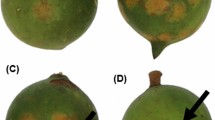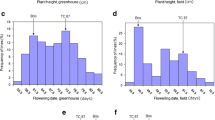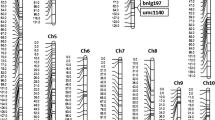Abstract
The amount of genetic variation for resistance to foot rot caused by Pseudocercosporella herpotrichoides, Fusarium spp., and Microdochium nivale and for resistance to head blight caused by Fusarium culmorum are important parameters when estimating selection gain from recurrent selection in winter rye. One-hundred and eighty-six full-sib families of the selfincompatible population variety Halo, representing the Petkus gene pool, were tested for foot-rot resistance at five German location-year combinations (environments) and for head-blight resistance in three environments with artificial inoculation in all but one environment. Foot-rot rating was based on 25 stems per plot scored individually on a 1–9 scale. Head-blight resistance was plotwise scored on a 1–9 scale and, additionally, grain-weight per spike was measured relative to the non-inoculated control plots. Significant estimates of genotypic variance and medium-sized heritabilities (h 2=0.51–0.69) were observed in the combined analyses for all resistance traits. In four out of five environments, the amount of genetic variance was substantially smaller for foot-rot than for head-blight rating. Considerable environmental effects and significant genotype-environment interactions were found for both foot-rot and head-blight resistance. Coefficients of error-corrected correlation among environments were considerably closer than phenotypic correlations. No significant association was found between the resistances to both diseases (r=-0.20 to 0.17). In conclusion, intra-population improvement by recurrent selection should lead to substantial higher foot-rot and head-blight resistances due to significant quantitative genetic variation within Halo. Selection should be carried out in several environments. Lack of correlation between foot-rot and head-blight resistance requires separate infection tests for improving both resistances.
Similar content being viewed by others
References
Bojarczuk M, Bojarczuk J (1985) Breeding of rye resistant to fungus diseases. In: Proc Eucarpia Meeting of the Cereal Section on rye, part II. Svalöf, Sweden, June 11–13. Svalöf AB Publ, Svalöf, Sweden, pp 351–364
Chelkowski J (1989) Formation of mycotoxins produced by Fusaria in heads of wheat, triticale, and rye. In: Chelkowski J (ed) Fusarium-mycotoxins, taxonomy, and pathogenicity. Elsevier, Amsterdam, pp 63–84
Cochran WG, Cox GM (1957) Experimental designs, 2nd edn. Wiley, New York
Duben J, Fehrmann H (1979) Vorkommen und Pathogenität von Fusarium-Arten an Winterweizen in der Bundesrepublik Deutschland. I. Artenspektrum und jahreszeitliche Sukzession an der Halmbasis. Z PflKrankh PflSchutz 86:638–652
Duben J, Fehrmann H (1980) Vorkommen und Pathogenität von Fusarium-Arten an Winterweizen in der Bundesrepublik Deutschland. III. Zusammenhang zwischen dem Befall der Halmbasis und der Ahre. Z PflKrankh PflSchutz 87:1–12
Falconer DS (1989) Introduction to quantitative genetics, 3rd edn. Longman, New York
Frauenstein K (1987) Untersuchungen zur Schadwirkung von Pseudocercosporella herpotrichoides (Fron) Deight. an Winterroggen. Nachrichtenbl Deut Pflanzenschutzd (DDR) 41:135–139
Geiger HH (1985) Hybrid breeding in rye (Secale cereale L.). In: Proc Eucarpia Meeting of the Cereal Section on Rye, part I. Svalöf, Sweden, June 11–13. Svalöf AB Publ, Svalöf, Sweden, pp 237–265
Geiger HH (1988) Züchtung. In: Seibel W, Steller W (eds) Roggen. Behr, Hamburg, pp 25–43
Geiger HH, Heun M (1989) Genetics of quantitative resistance to fungus diseases. Annu Rev Phytopathol 27:317–341
Höxter H, Sieber G, Miedaner T, Geiger HH (1992) Test systems for evaluating quantitative resistance to Fusarium foot rot in inbred lines of winter rye. Plant Breed 108:274–282
Meyer J (1985) Breeding for resistance. In: Proc Eucarpia Meeting of the Cereal Section on Rye, part II, Svalöf, Sweden, June 11–13. Svalöf AB Publ, Svalöf, Sweden, pp 335–349
Miedaner T, Ludwig WF, Höxter H, Beyer W, Geiger HH (1993a) Analysis of quantitative resistance to Fusarium foot rot in winter rye. Hod Rosl Aklim Nasien (special edition) 37(3): 51–59
Miedaner T, Borchardt DC, Geiger HH (1993b) Genetic analysis of inbred lines and their crosses for resistance to head blight (Fusarium culmorum, F. graminearum) in winter rye. Euphytica 65:123–133
Miedaner T, Ludwig WF, Geiger HH (1995a) Inheritance of foot-rot resistance in winter rye. Crop Sci 35: 388–393
Miedaner T, Ziegler DE, Geiger HH (1995b) Variation and covariation for quantitative resistance to head blight (Fusarium culmorum) in two testcross series of S2 lines in winter rye. Plant Breed 114:155–159
Mielke H (1988) Untersuchungen über Fusarium culmorum (W.G.Sm.) Sacc. als Fuß und Ahrenkrankheitserreger beim Weizen. Mitt Biol Bundesanst Landu Forstw Berlin-Dahlem 238:1–101
Mode CF, Robinson HF (1959) Pleiotropism and the genetic variance and covariance. Biometrics 15:518–537
Nirenberg HI (1981) A simplified method for identifying Fusarium spp. occurring on wheat. Can J Bot 59:1599–1609
Perkowski J, Miedaner T, Geiger HH, Müller HM, Chelkowski J (1995) Occurrence of Deoxynivalenol (DON), 3-Acetyl-DON, Zearalenone and Ergosterol in winter rye infected with Fusarium culmorum. Cereal Chem (in press)
Snijders CHA (1990) The inheritance of resistance to head blight caused by Fusarium culmorum in winter wheat. Euphytica 50:11–18
Sprague GF, Eberhart SA (1977) Corn breeding. In: Sprague GF (ed) Corn and corn improvement. American Society of Agronomy, Madison, Wisconsin, USA, pp 305–362
Utz HF (1991a) PLABSTAT. A computer programe for the statistical analysis of plant breeding experiments. Institute of Plant Breeding, Seed Science and Population Genetics, University of Hohenheim, Stuttgart, Germany
Utz HF (1991b) PLABCOV. A computer program for the computation of variances and covariances. Institute of Plant Breeding, Seed Science and Population Genetics, University of Hohenheim, Stuttgart, Germany
Wricke G, Weber WE (1986) Quantitative genetics and selection in plant breeding. De Gruyter, Berlin New York
Author information
Authors and Affiliations
Additional information
Communicated by G. Wenzel
Rights and permissions
About this article
Cite this article
Miedaner, T., Fromme, F.J. & Geiger, H.H. Genetic variation for foot-rot and Fusarium head-blight resistances among full-sib families of a self-incompatible winter rye (Secale cereale L.) population. Theoret. Appl. Genetics 91, 862–868 (1995). https://doi.org/10.1007/BF00223893
Received:
Accepted:
Issue Date:
DOI: https://doi.org/10.1007/BF00223893




